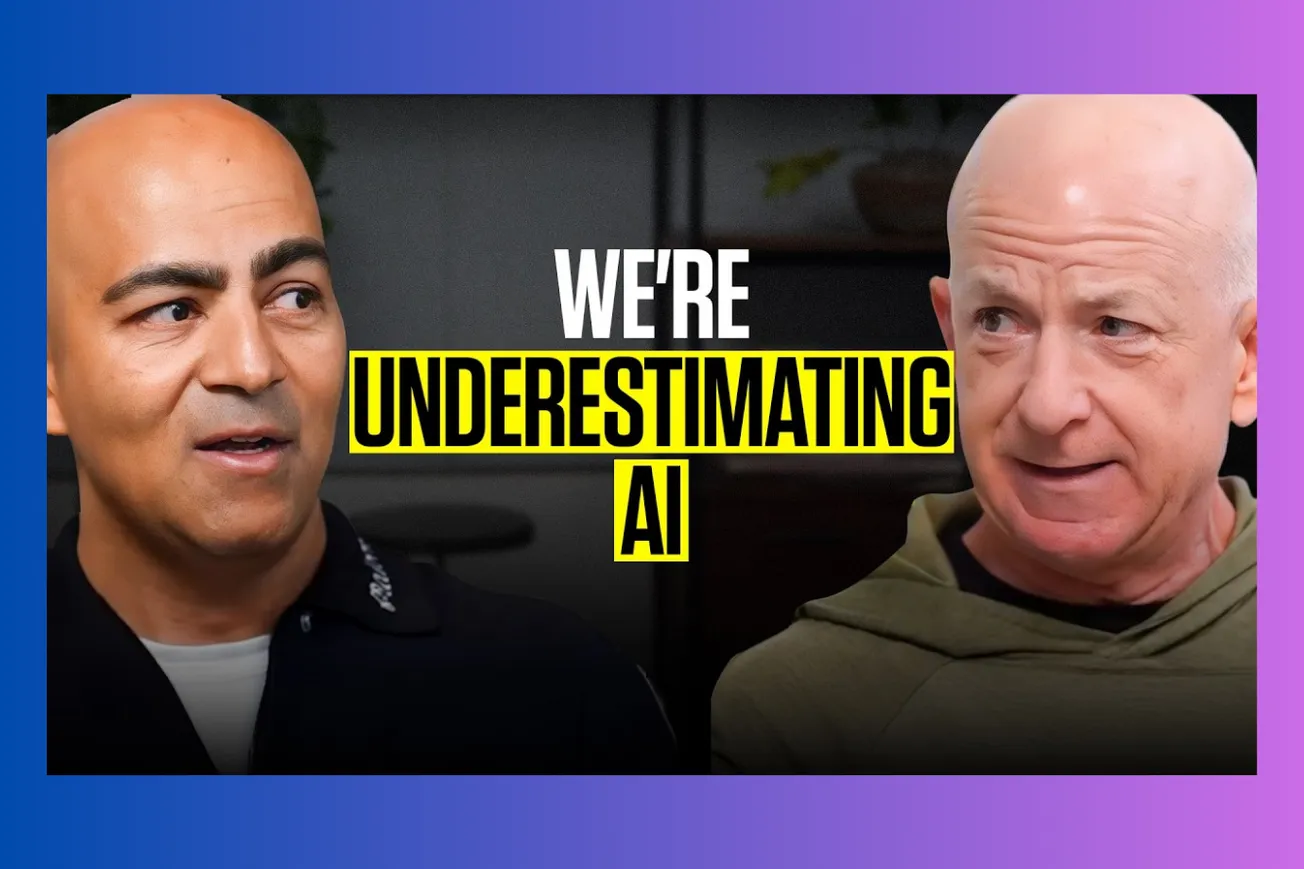Table of Contents
Former Microsoft executive Steven Sinofsky argues we're in the earliest stages of the AI revolution—comparable to the 64K IBM PC era—where people are still figuring out how basic functionality works before achieving real productivity.
AI development mirrors early computing: lots of promise, lots of problems, and a long journey ahead.
Key Takeaways
- AI is at the 64K IBM PC stage where people are still learning how to use the tools productively
- "Vibe writing" represents the first area where AI achieves full autonomy, unlike coding which remains constrained
- Automation will first succeed in high-friction, low-judgment tasks rather than complex decision-making roles
- The "year of agents" is really the "decade of agents"—true automation takes much longer than predicted
- Most jobs involve exception handling and uncertainty that resist straightforward automation
- AI-generated content represents a quality shift similar to moving from typewriters to word processors
- Google's platform advantages remain strong despite concerns about falling behind in AI innovation
The 64K IBM PC Metaphor: We're Still Figuring Out Basics
Steven Sinofsky draws parallels between today's AI landscape and the early personal computer era, when users struggled with fundamental limitations while promising grand visions.
- Early PC users faced 64K memory constraints with programs too large to run, similar to AI's current limitations in basic arithmetic and reliability
- People attempt to use AI like existing computing tools rather than learning its unique characteristics as "people spirits" with jagged intelligence
- The technology doesn't yet deliver on promises to replace search, Excel, or other applications due to fundamental accuracy issues
- Andre Karpathy's analysis highlights the need to relearn productivity approaches for this fundamentally different tool type
- Platform transitions historically start with tools that developers can make work through determination and iteration
- Current AI enthusiasm resembles early platform hype cycles where capabilities are overstated relative to actual functionality
We must relearn how to be productive with AI tools rather than forcing them into existing workflows.
Vibe Writing vs. Vibe Coding: Where AI Actually Works
The distinction between writing and coding applications reveals where AI achieves genuine autonomy versus where it remains constrained by technical limitations.
- "Vibe writing" enables full autonomy today—AI can produce detailed, compelling content that serves immediate needs
- College students already use AI for writing assignments while businesses debate appropriateness and policy implications
- Coding applications face significant constraints in what models can actually execute versus what they can conceptually understand
- Understanding technical boundaries and limitations will define text-to-code development for the next two years
- The calculator analogy applies: just as calculators changed math homework without eliminating mathematical thinking, AI transforms writing processes
- Quality control remains essential—AI writing requires human editing just as calculator outputs need verification
Vibe writing represents the first domain where AI delivers full autonomy that users can rely on immediately.
The Automation Spectrum: High Friction, Low Judgment First
Successful automation will emerge in tasks that combine high friction with low judgment requirements, avoiding areas demanding significant human decision-making.
- Personal loan refinancing exemplifies high-friction, low-judgment tasks ideal for agent automation
- Tax preparation involves high friction but enormous judgment requirements, making automation problematic
- Most financial services decisions involve more complexity than simple "cheapest option" optimization
- Consumer choice preferences exceed what agents can capture through simple optimization algorithms
- Economic incentives require differentiation and branding that resist faceless, automated commodity services
- The Iron Man analogy provides a useful framework: partial autonomy with human control sliders rather than full replacement
True automation requires formal definitions of correctness, which exist in games like chess but not in most business contexts.
Why Most Jobs Resist Automation
The complexity of real-world work involves uncertainty, exception handling, and judgment that make comprehensive automation extremely difficult.
- Medical diagnosis exemplifies uncertainty—doctors deal with ambiguous information requiring professional judgment rather than algorithmic certainty
- Radiologists embraced AI as another tool (like MRI improvements) rather than replacement technology
- Tax preparation consists of "cascading if-and-switch statements of exceptions" that require knowing answers to all edge cases
- Product management addresses ambiguity that prevents organizational progress—a fundamentally human coordination function
- Most professional work involves exception handling rather than routine processes suitable for automation
- The hospital Excel example demonstrates how adding "certain" tools to uncertain environments doesn't provide value
Healthcare professionals understand that their jobs involve managing uncertainty rather than executing deterministic processes.
The Platform Transition in Public
Unlike previous technology transitions that happened within technical communities, AI development occurs in full public view, creating unrealistic expectations and premature claims.
- Earlier computing transitions happened in user groups, magazines, and technical communities before mainstream attention
- Current AI development unfolds on CNN, social media, and Discord with global visibility from the beginning
- "Vibe coding for clout" leads to exaggerated claims about AI programming capabilities
- Developers spend 18 hours struggling with problems they claim are "easy" in public demonstrations
- Prompt engineering essentially creates new programming languages disguised as natural language interaction
- The history of programming shows consistent overpromising and underdelivering across technology transitions
Public platform transitions create pressure for premature claims about capabilities that don't yet exist reliably.
Programming Language Evolution and AI Development
AI development follows patterns similar to previous programming language innovations, with gradual improvement rather than revolutionary transformation.
- Object-oriented programming took 10 years (1980-1990) to reach peak hype while delivering incremental rather than order-of-magnitude improvements
- Low-code platforms followed similar patterns of initial promise followed by reality constraints
- Current text-to-app development essentially creates new programming languages with English-like syntax
- Most programming advances provide constant factors of improvement rather than mathematical order-of-magnitude changes
- AI writing may achieve order-of-magnitude improvement where previous technologies provided linear gains
- The underlying language models improve dramatically compared to static programming language capabilities
Programming language history suggests measured expectations for revolutionary change while acknowledging genuine improvements.
The Quality Bar Evolution
AI-generated content changes quality expectations similar to how word processors transformed document standards despite initial resistance.
- College permission requirements for word processors paralleled current institutional AI policy debates
- Dot matrix printer output looked "computerized" compared to typewriter standards but provided superior editing capabilities
- Business writing quality may not decline with AI assistance since much existing content lacks accuracy anyway
- AI errors will replace human errors rather than eliminating mistakes entirely, similar to autocorrect functionality
- Medical AI serves 80% of the world with no current access to medical knowledge or services
- Success measurement shifts from perfection to "better than available alternatives"
Quality standards evolve to accommodate new capabilities rather than maintaining historical benchmarks.
AI-Generated Culture and Creativity
AI content generation will produce successful creative works while raising questions about artistic authenticity and cultural innovation.
- Bestselling AI-generated novels will emerge within years, likely revealed as AI-assisted after achieving success
- Language models function as "averaging machines" that may struggle with edge-of-culture creativity
- Artists native to AI technology will develop capabilities beyond current "slop" content
- Low barrier-to-entry creation provides creative fulfillment while potentially raising quality ceilings for skilled practitioners
- Enterprise case studies and business content benefit immediately from AI generation capabilities
- The world needs more "average" content since most output isn't exceptional by definition
Creative authenticity questions matter less than practical content needs across various quality levels.
Big Tech Adaptation and Platform Disruption
Established technology companies possess advantages in platform transitions but face challenges adapting core business models and development approaches.
- Google's IO demonstrations show their ability to deploy comprehensive AI capabilities across product lines
- "Shock and awe" asset deployment matters during platform transitions when companies pivot entire organizations
- The real question involves whether Google can transform product development and go-to-market approaches rather than just deploy technology
- Company death predictions ignore historical resilience—IBM has "died" multiple times while continuing operations
- Platform disruption happens through altered development contexts rather than superior individual technologies
- Losing influence positions differs from company extinction during technology transitions
Big tech companies' platform transition success depends on organizational adaptation rather than just technical capabilities.
Common Questions
Q: How long will AI development take to mature?
A: We're in the "decade of agents" rather than the "year of agents"—true automation requires years of development.
Q: What types of work will AI automate first?
A: High-friction, low-judgment tasks like loan refinancing rather than complex decision-making requiring human expertise.
Q: Will AI replace programmers entirely?
A: History suggests gradual productivity improvements rather than wholesale replacement, similar to previous programming language evolution.
Q: How should businesses approach AI content quality?
A: Focus on "better than alternatives" rather than perfection, especially for routine business communications.
Q: Can established tech companies adapt to AI disruption?
A: Companies like Google have deployment advantages but must transform development approaches to maintain influence.
The AI revolution resembles early computing more than science fiction—messy, incremental, and requiring patient development of practical applications. Understanding this timeline helps set realistic expectations for transformative change.





